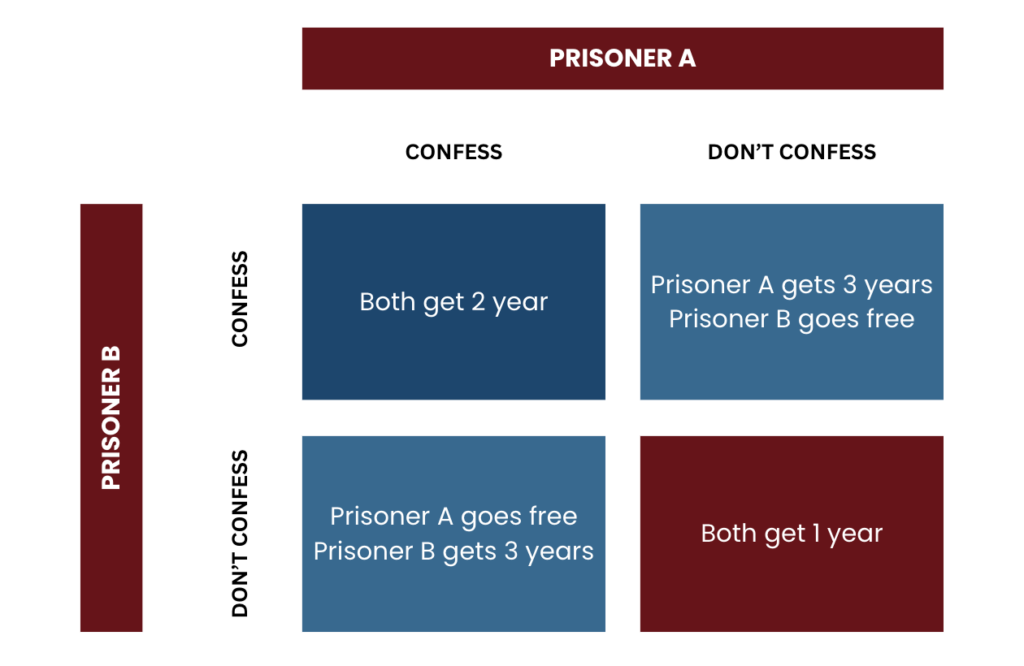In competitive environments, the decisions businesses make often depend on the likely actions of others. This interdependence creates a game-like situation where each party’s success hinges on the choices of others. One of the most classic examples of this scenario is the Prisoner’s Dilemma—a concept in game theory that reveals deep insights about trust, cooperation, and competition. But how does the Prisoner’s Dilemma apply to business, and what lessons can we draw from it to improve strategy?
In this article, we’ll explore the mechanics of the Prisoner’s Dilemma and show how it can shape business strategies, particularly in competitive industries where the choices made by one company impact its competitors.
What is the Prisoner’s Dilemma?
The Prisoner’s Dilemma is a scenario in game theory involving two individuals arrested for a crime. They are held in separate cells and cannot communicate. Each prisoner faces a choice: to betray the other (by confessing to the crime) or remain silent. Here’s the twist:
- If both prisoners remain silent, they each serve a short sentence (say, 1 year).
- If one prisoner betrays the other while the other stays silent, the betrayer goes free while the silent prisoner serves a longer sentence (say, 3 years).
- If both prisoners betray each other, they both receive a moderate sentence (say, 2 years).

The dilemma lies in the fact that each prisoner’s best choice, in isolation, is to betray the other to minimize their own risk. However, if they both choose betrayal, they’ll end up worse off than if they had cooperated by remaining silent.
Key Insight: The Prisoner’s Dilemma demonstrates that individual rationality can lead to collective irrationality. In other words, when each party acts in its own self-interest without cooperation, they may end up in a worse position than if they had worked together.
The Prisoner’s Dilemma in Business Strategy
In business, companies frequently face situations that mirror the Prisoner’s Dilemma. Let’s look at some common scenarios where cooperation could lead to mutual benefits, yet the incentive to compete (or betray) is strong.
1. Price Wars
Price wars are one of the clearest examples of the Prisoner’s Dilemma in action. When two companies compete in the same market, each one faces pressure to lower prices to capture more market share. However, if both companies continually reduce prices, they may both suffer from reduced profit margins.
- Example: Suppose two competing airlines begin a price-cutting campaign to attract more passengers. If both continue to lower prices, neither will gain a significant long-term advantage, and both will experience profit erosion. Yet, the fear that the other company will undercut prices often prevents them from cooperating on price stability.
Lesson for Strategy: In cases like these, establishing informal agreements or following industry pricing standards can help companies avoid destructive price wars. Companies that focus on differentiating their offerings rather than engaging in price cuts often achieve greater long-term profitability.
2. Advertising Battles
Similar to price wars, companies in highly competitive industries sometimes engage in advertising battles, investing heavily in marketing to attract the same audience. When one company ramps up its advertising, competitors may feel forced to do the same, leading to escalating costs with limited gains in market share.
- Example: Two consumer goods brands may increase advertising spending to attract customers. If both companies invest heavily in ads, the additional sales may not compensate for the high costs, leading to reduced profit margins for both.
Lesson for Strategy: Cooperation in this context may mean focusing on differentiated brand messages or targeting unique customer segments rather than competing for the same audience. Another strategy is to invest in long-term customer loyalty programs that aren’t easily disrupted by competitors’ marketing efforts.
3. Innovation Races
In technology and pharmaceuticals, companies often engage in “innovation races” to develop and release new products faster than their competitors. While being first-to-market can yield competitive advantages, these races can also lead to rushed development and increased costs, sometimes at the expense of product quality.
- Example: Tech giants racing to release the latest smartphone models often incur higher costs and, at times, quality issues. If these companies collaborated on research, they might achieve better outcomes in terms of product quality and customer satisfaction.
Lesson for Strategy: While direct cooperation may not always be possible, businesses can benefit from collaborating in areas of pre-competitive research, setting industry standards, or pursuing joint ventures. Strategic partnerships often allow companies to share costs and risk, potentially leading to a better outcome for all parties involved.
Read more: What is a prisoner’s dilemma?
Strategies for Overcoming the Prisoner’s Dilemma in Business
Understanding the dynamics of the Prisoner’s Dilemma can help leaders make strategic decisions that benefit both their company and the broader market. Here are some strategies to foster cooperation and avoid the negative consequences of pure competition:
1. Build Trust with Competitors
Trust is at the heart of cooperation. Establishing trust-based relationships with competitors can lead to informal agreements that prevent destructive behaviors like price wars. For example, companies might follow industry standards, engage in transparent communication, or participate in trade associations to establish a culture of cooperation.
2. Focus on Long-Term Gains over Short-Term Wins
The Prisoner’s Dilemma demonstrates the risk of prioritizing short-term self-interest over collective long-term benefits. Companies should consider the larger impact of their decisions. For example, instead of cutting prices to attract customers quickly, investing in brand equity, customer loyalty, or product innovation can yield more sustainable profits.
3. Differentiate Rather than Compete on Price Alone
One way to avoid the pitfalls of the Prisoner’s Dilemma is to differentiate products or services. When companies offer unique value propositions, they reduce the temptation to engage in price or advertising battles, creating a more stable environment where businesses can thrive without undermining one another.
4. Engage in Strategic Partnerships
In some cases, direct competitors can benefit from cooperating in areas that offer mutual advantages. Strategic partnerships, joint ventures, and research collaborations allow companies to share resources, spread risk, and avoid the costs associated with competitive escalation.
Exploring Mintzberg’s 5 Ps of Strategy: A Comprehensive Guide for Business Leaders
Real-World Examples of the Prisoner’s Dilemma in Business
- OPEC and Oil Pricing: The Organization of the Petroleum Exporting Countries (OPEC) faces a classic Prisoner’s Dilemma in controlling oil production. Each country has an incentive to produce more oil to maximize revenue. However, if all members produce more, oil prices fall, which reduces revenue across the board. OPEC’s agreements to limit production represent an attempt to foster cooperation for collective benefit.
- Airline Alliances: Airline alliances like Star Alliance and SkyTeam enable competing airlines to cooperate on certain routes, share lounges, and even coordinate flight schedules. By working together, airlines avoid direct competition on certain routes and provide added value to customers through shared services, benefiting both the airlines and their customers.
- The Smartphone Market: Apple and Samsung, the leading players in the smartphone market, often engage in innovation races to release the latest models. While competition drives innovation, it also leads to rapid product cycles and significant R&D costs. These companies sometimes face a dilemma: slow down and reduce costs or speed up and risk quality issues. Balancing cooperation and competition, both companies often license patents from each other to avoid costly legal battles.
- Streaming Wars – Netflix vs. Disney+: In the fiercely competitive streaming industry, major players like Netflix and Disney+ constantly face decisions mirroring the Prisoner’s Dilemma. Each platform strives to attract new subscribers by expanding its library, increasing exclusives, and offering competitive pricing. If both companies push aggressive marketing and content production, they each bear high costs, cutting into profits. Yet if either platform reduces spending, it risks losing subscribers to the other. While competition remains fierce, both Netflix and Disney+ have, at times, chosen to share or license certain content. By doing so, they offset the need for constant expansion and attract niche audiences that benefit both platforms. This form of cooperative strategy enables them to manage content costs and secure longer-term profitability.
Conclusion
The Prisoner’s Dilemma reveals a fundamental truth in business: pure competition can sometimes lead to suboptimal outcomes for everyone involved. When companies focus solely on their self-interest, they risk creating environments where everyone’s profitability suffers. By understanding and recognizing situations where cooperation could lead to better outcomes, business leaders can make strategic decisions that foster stability, trust, and mutual benefit.
Ultimately, successful business strategy isn’t just about outmaneuvering competitors—it’s also about knowing when collaboration can enhance profitability and resilience. The Prisoner’s Dilemma serves as a powerful reminder that in some cases, the best way to “win” is not to play against others, but to find ways to win together.


